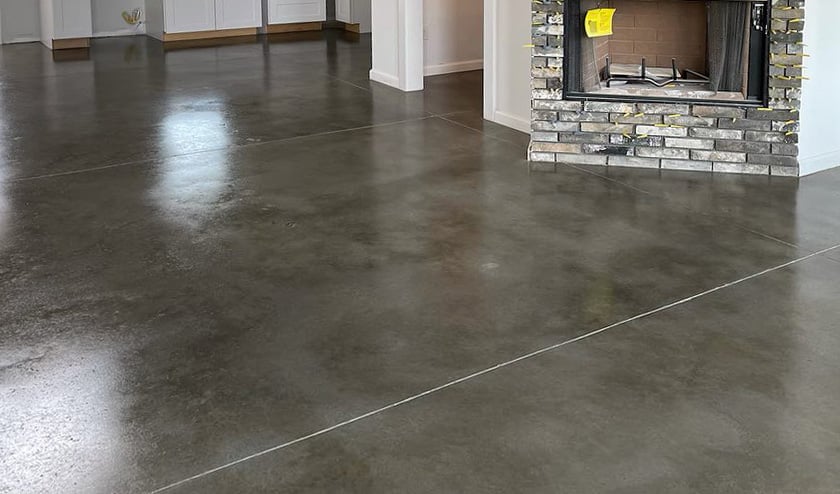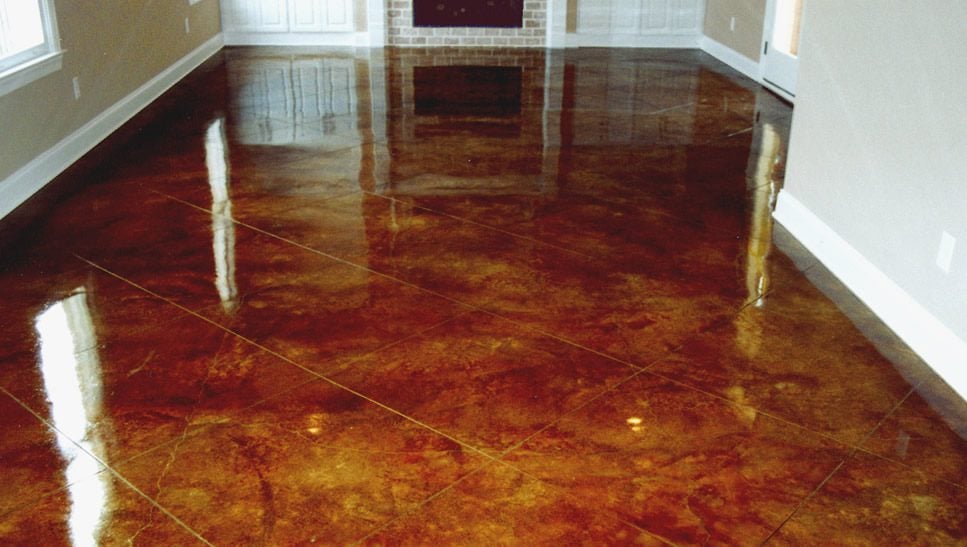All Regarding Stained Concrete: A Comprehensive Guide to Its Benefits and Applications
Stained concrete has become a prominent option for both household and industrial areas. Its capacity to integrate aesthetic charm with usefulness makes it an appealing choice. Various discoloration methods provide a variety of shades and surfaces, enabling personalization. Nevertheless, the advantages prolong past look. Comprehending its applications and maintenance demands is essential for any person considering this functional product. The subtleties of stained concrete invite even more exploration.
What Is Stained Concrete?

Staining can be used to various surface areas, including floors, driveways, and patios, making it a functional alternative for both interior and outdoor spaces. The treatment can attain a variety of appearances, from earthy tones to bold, contemporary layouts. Unlike paint, stained concrete keeps its look in time, as it ends up being an indispensable part of the concrete itself. Overall, stained concrete acts as an efficient technique for transforming normal concrete right into aesthetically striking surface areas.
Advantages of Stained Concrete
Stained concrete deals substantial advantages, especially in aesthetic appeal and toughness - stained concrete floors. Its vibrant colors and distinct patterns improve the visual charm of any type of space, making it a popular choice for both property and industrial applications. Furthermore, the durability of stained concrete guarantees that it continues to be a useful investment gradually, withstanding deterioration
Aesthetic Charm
Among one of the most compelling advantages of using stained concrete is its impressive visual charm. Stained concrete deals an one-of-a-kind and flexible appearance that can complement different design styles, from contemporary to rustic. The infusion of vibrant colors and detailed patterns enables homeowners and developers to create customized surfaces that can boost the general atmosphere of an area. Unlike typical flooring options, stained concrete can mimic the look of all-natural stone or sleek marble, supplying an upscale appearance without the connected expenses. Furthermore, the shiny surface choices can mirror light, more brightening insides. This adaptability makes stained concrete a popular choice for both domestic and commercial applications, where aesthetic impact is critical.
Durability and Long life
The excellent visual qualities of stained concrete are complemented by its exceptional durability and longevity - local stained concrete. Stained concrete surface areas are immune to damage, making them suitable for high-traffic locations both inside your home and outdoors. Their robust nature means they can stand up to harsh climate condition, consisting of severe temperatures, rain, and UV direct exposure, without significant degradation. On top of that, stained concrete requires minimal upkeep compared to other flooring options, as it does not need regular sealing or refinishing. This durability not only minimizes replacement expenses however additionally adds to a sustainable structure strategy. On the whole, stained concrete offers an enduring remedy that incorporates visual charm with functional benefits, ensuring its value gradually
Various Sorts Of Staining Techniques
Different staining strategies can considerably impact the aesthetic qualities of concrete surfaces. The three primary techniques consist of acid staining, which reacts chemically with the concrete, water-based discoloration, which offers a more comprehensive array of colors, and overlay staining options that provide a fresh surface area. Each method has distinct qualities and applications that provide to different style preferences and task needs.
Acid Discoloration Approach
Just how can home owners transform simple concrete surface areas into visually striking features? One efficient approach is acid staining, a prominent method that improves the natural beauty of concrete. This procedure involves using an option of water, hydrochloric acid, and metal salts to the concrete surface area. As the acid responds with the lime present in the concrete, it develops abundant, variegated shades that resemble marble or rock. Acid staining is understood for its longevity and resistance to fading, making it a long-lasting selection for both indoor and outside applications. However, it is vital to note that the outcomes can vary based on the initial concrete shade and appearance - stained concrete contractors. Correct application and sealing are essential for attaining the desired visual and long life
Water-Based Staining Strategy
A popular alternative to acid discoloration, the water-based staining technique uses home owners a flexible means to boost concrete surfaces. This technique uses water-soluble dyes and pigments, permitting a wide variety of shades and coatings. Unlike acid discolorations, water-based discolorations can be put on unsealed concrete and offer an easier cleaning process. The results can accomplish a more consistent look and can be layered to develop one-of-a-kind effects. In addition, water-based discolorations are normally much less harmful and discharge fewer unstable natural compounds (VOCs), making them a lot more eco pleasant. Homeowners might appreciate the click here to read capability to customize their concrete surfaces with numerous shades, enabling imaginative expression while maintaining durability and durability in their floor covering selections.
Overlay Staining Options
Countless overlay staining alternatives exist for house owners aiming to renew their concrete surface areas. One popular choice is acid staining, which reacts chemically with the concrete to produce rich, variegated colors. An additional alternative is water-based staining, offering a wider color scheme and simpler application. Additionally, concrete overlays can be incorporated with patterns for intricate styles, boosting appearances. For a more textured surface, house owners may consider making use of stamped overlays that simulate natural materials like rock or floor tile. Each technique provides one-of-a-kind advantages, from sturdiness to customization, permitting for a personalized touch. Eventually, the choice of overlay staining depends on the wanted look and the condition of the existing concrete, ensuring a refreshed and appealing surface.
Applications of Stained Concrete
Stained concrete deals a flexible solution for various applications, boosting both aesthetic charm and functionality. This product is generally utilized in residential, commercial, and pop over to this site commercial setups, making it a popular choice amongst architects and designers. In homes, stained concrete can act as stylish flooring or outdoor patio areas, providing an innovative appearance while remaining resilient.
In industrial spaces, such as retailers and dining establishments, stained concrete adds to a modern atmosphere and can withstand heavy foot traffic. In addition, stained concrete is significantly used in public rooms like parks and sidewalks, where its capability to resemble natural stone or various other materials adds visual passion.
Moreover, stained concrete is optimal for swimming pool decks and driveways, providing a slip-resistant surface that is easy to maintain. Overall, the versatility of stained concrete makes it ideal for many environments, satisfying varied preferences and needs.
Maintenance and Care for Stained Concrete
Appropriate maintenance ensures the durability and appeal of stained concrete surface areas. Routine cleaning is essential; making use of a mild detergent and water with a soft-bristle brush helps get rid of dust and gunk without harming the surface. It is a good idea to prevent harsh chemicals that can remove the stain or sealant.
Securing stained concrete is important for protection against wetness, stains, and put on. A high-quality sealer should be reapplied every one to three years, depending upon the traffic and exposure the surface sustains. In addition, resolving spills immediately will stop discoloration and discoloration.

Expense Factors To Consider for Stained Concrete Projects
When planning a stained concrete task, budget plan factors to consider play a crucial function in figuring out the total expense. The expenditures linked with stained concrete can vary substantially based on several elements. The size of the area to be stained straight influences product and labor costs. Larger rooms will normally require more resources. Second, the type of tarnish chosen-- acid-based or water-based-- can impact prices, with acid spots typically being extra expensive. Additionally, the complexity of the design, consisting of patterns or several shades, can increase labor costs. Preparation job, such as cleaning and grinding the concrete surface, includes in the preliminary expenditures also. Ultimately, the option in between do it yourself installation and hiring a professional specialist will better affect the budget plan. Recognizing these variables makes it possible for home owners to make enlightened monetary decisions regarding their stained concrete jobs, ensuring they achieve the desired aesthetic within their monetary ways.
Tips for Selecting the Right Stained Concrete for Your Area
Selecting the right stained concrete for a particular area includes careful contemplation of numerous elements beyond simply spending plan. Initially, one should examine the intended use the area. High-traffic zones may require even more long lasting finishes, while decorative applications can focus on appearances.
The color scheme is another crucial element; the chosen tones must harmonize with existing design and lighting. It's additionally important to take into account the surface area structure, as smooth coatings can boost elegance, while distinctive alternatives may ensure safety in wet locations.
Neighborhood climate and ecological conditions play a substantial role in the long life and upkeep of stained concrete, affecting the choice of sealants and coatings.
Lastly, talking to experts can offer useful understandings customized to certain requirements, ensuring the option of the suitable stained concrete that straightens with both performance and design.

Regularly Asked Questions
Can Stained Concrete Be Applied Over Existing Flooring?
Stained concrete can without a doubt be applied over existing floor covering, offered the surface area is stable and sufficiently prepared. This method permits an aesthetic upgrade without the need for full removal of the initial floor covering materials.
How Much Time Does Stained Concrete Last?
Stained concrete can last for decades when properly kept. Aspects such as web traffic, ecological conditions, and application techniques considerably affect its long life, with many setups staying vivid and intact for 10 to thirty years.
Is Stained Concrete Slippery When Damp?
Stained concrete can be unsafe when wet, as the surface may create a smooth surface area. Utilizing non-slip additives or distinctive surfaces can minimize this concern, enhancing safety and security without compromising the aesthetic allure of the concrete.
Can I Discolor Concrete Myself, or Should I Hire a Professional?
The decision to stain concrete personally or employ an expert depend upon skill level and task intricacy. While do it yourself discoloration can conserve cash, specialists assure excellent results, especially for intricate styles or huge surfaces.
What Colors Are Readily Available for Stained Concrete?
The variety of colors offered for stained concrete includes natural tones like browns and tans, dynamic shades such as reds and blues, and softer tones like pastels. This combination enables creative, customized design options.